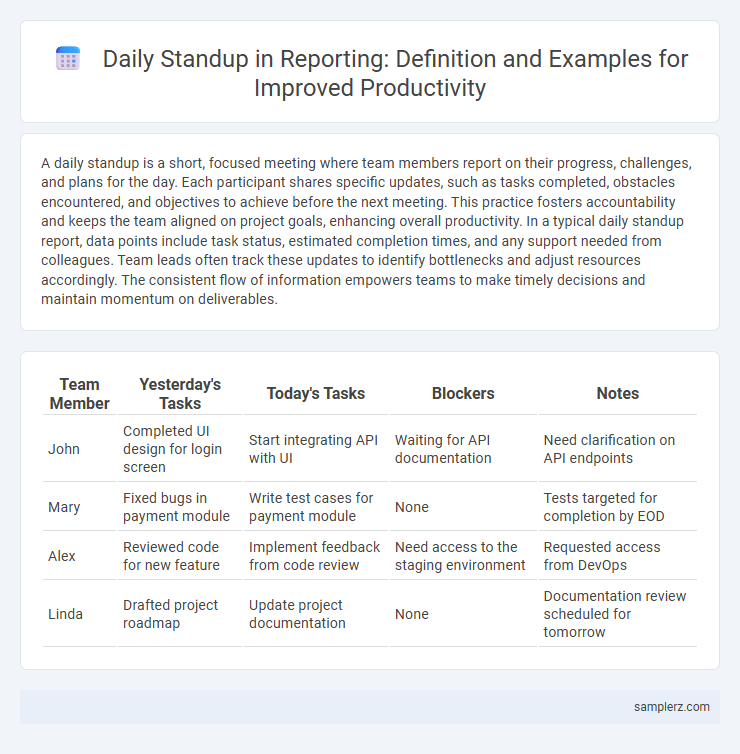A daily standup is a short, focused meeting where team members report on their progress, challenges, and plans for the day. Each participant shares specific updates, such as tasks completed, obstacles encountered, and objectives to achieve before the next meeting. This practice fosters accountability and keeps the team aligned on project goals, enhancing overall productivity. In a typical daily standup report, data points include task status, estimated completion times, and any support needed from colleagues. Team leads often track these updates to identify bottlenecks and adjust resources accordingly. The consistent flow of information empowers teams to make timely decisions and maintain momentum on deliverables.
Table of Comparison
| Team Member | Yesterday's Tasks | Today's Tasks | Blockers | Notes |
|---|---|---|---|---|
| John | Completed UI design for login screen | Start integrating API with UI | Waiting for API documentation | Need clarification on API endpoints |
| Mary | Fixed bugs in payment module | Write test cases for payment module | None | Tests targeted for completion by EOD |
| Alex | Reviewed code for new feature | Implement feedback from code review | Need access to the staging environment | Requested access from DevOps |
| Linda | Drafted project roadmap | Update project documentation | None | Documentation review scheduled for tomorrow |
Key Components of an Effective Daily Standup Report
An effective daily standup report includes three key components: progress updates, identification of blockers, and clear prioritization of tasks. Team members succinctly share what they accomplished since the last meeting, what they plan to achieve before the next one, and any obstacles hindering their progress. This structured communication enhances transparency, accelerates issue resolution, and keeps the project aligned with sprint goals.
Sample Daily Standup Meeting Agenda
A sample daily standup meeting agenda typically includes a brief update on completed tasks, identification of current obstacles, and alignment on priorities for the day. Team members report progress using key metrics such as task completion rates and sprint velocity. This structured approach enhances transparency, accountability, and team productivity in agile workflows.
How to Structure Your Daily Standup Reporting
Structure your daily standup reporting by first highlighting key accomplishments aligned with sprint goals to ensure transparency and progress tracking. Follow with clear identification of current challenges or blockers to facilitate timely support and problem-solving. Conclude by outlining immediate next steps and priorities to maintain team focus and streamline workflow.
Daily Standup Reporting: Example Questions and Answers
Daily standup reporting enhances team productivity by providing clear, concise updates through targeted questions. Common example questions include: "What did you accomplish yesterday?", "What are your plans for today?", and "Are there any blockers impeding your progress?". These answers enable quick issue identification and foster effective collaboration, ensuring consistent project momentum.
Best Practices for Daily Standup Reports in Agile Teams
Daily standup reports in Agile teams should focus on clear, concise updates highlighting progress, blockers, and planned tasks to maintain team alignment. Using time-boxed meetings under 15 minutes ensures efficiency and keeps discussions focused on actionable items. Encouraging team members to prepare brief, relevant reports fosters accountability and accelerates sprint goal achievement.
Real-Life Daily Standup Report Templates
Real-life daily standup report templates typically include key elements such as progress updates, obstacles encountered, and planned tasks for the day. Common formats like the Scrum Board or Jira dashboards enhance transparency and keep team members aligned on priorities. Integrating time-tracking tools and concise bullet points optimizes clarity and accelerates the reporting process.
Common Mistakes in Daily Standup Reporting
Common mistakes in daily standup reporting include providing overly detailed updates that consume valuable meeting time and obscure key priorities. Team members often skip discussing blockers, which hinders timely problem-solving and team alignment. Additionally, failing to prepare concise, relevant progress reports leads to ineffective communication and reduced productivity.
Metrics to Track in Daily Standup Reports
Tracking key metrics such as completed tasks, blockers encountered, and planned activities enhances the effectiveness of daily standup reports. Monitoring velocity, cycle time, and team member participation provides actionable insights to improve productivity and workflow. Visualizing these metrics with tools like burn-down charts or Kanban boards supports transparent progress tracking and timely issue resolution.
How to Encourage Team Engagement in Standup Reporting
Encourage team engagement in daily standup reporting by creating a safe space where every member feels valued and heard, fostering open communication and trust. Use interactive tools like digital whiteboards or time-boxed speaking turns to maintain focus and equal participation, enhancing accountability and collaboration. Prioritize concise updates centered on progress, obstacles, and next steps to keep the meeting efficient and goal-oriented.
Tips for Virtual Daily Standup Reporting
Virtual daily standup reporting improves team productivity by maintaining concise and focused updates within a fixed 15-minute timeframe, emphasizing key project progress and immediate roadblocks. Using collaboration tools like Slack or Microsoft Teams alongside a shared digital task board ensures transparency and real-time status tracking. Encouraging participants to prepare updates in advance and mute distractions fosters engagement, reducing meeting fatigue in remote work settings.

example of daily-standup in reporting Infographic
 samplerz.com
samplerz.com